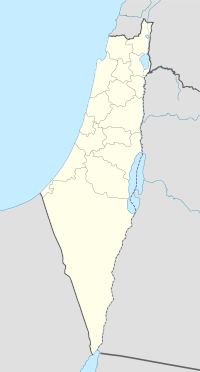Al-Naghnaghiyya
| Naghnaghiya | |
|---|---|
| Arabic | النغْنغية |
| Also spelled | Al-Naghnaghiyya |
| Subdistrict | Haifa |
| Coordinates | 32°36′12.2″N 35°09′26.9″E / 32.603389°N 35.157472°ECoordinates: 32°36′12.2″N 35°09′26.9″E / 32.603389°N 35.157472°E |
| Palestine grid | 164/223 |
| Population | 416 (1931) |
| Area | 12,139 dunams |
| Date of depopulation | 12-13 April 1948 |
| Cause(s) of depopulation | Military assault by Yishuv forces |
Naghnaghiya (Arabic: النغْنغية, Al-Naghnaghiyya) was a Palestinian Arab village, 28.5 kilometers (17.7 mi) southeast of Haifa. It was depopulated before the outbreak of the 1948 Arab-Israeli war.
The village was on the north edge of a hill at the edge of a wadi bed, overlooking the Jezreel Valley and the Nazareth hills to the north and northeast. It was the smallest of a group of three villages (known collectively as al-Ghubayyat) located together; the others were Al-Ghubayya al-Fawqa and Al-Ghubayya al-Tahta. Next to al- Naghnaghiya was an artificial mound that bore the same name. Two kilometers to the southeast, on the highway to Jenin was Tall al-Mutasallim, identified with Megiddo.
In 1888, during Ottoman rule, an elementary school was built that was shared by the three al-Ghubayyat villages.
In the British Mandate of Palestine period, in the 1922 census of Palestine Al Naghnaghiyeh had a population of 272; all Muslims, increasing in the 1931 census to 416, still all Muslims, in a total of 78 houses.
In 1945 the population of Al-Ghubayya al-Fawqa, Al-Ghubayya al-Tahta and Naghnaghiya was 1,130, all Muslims, and it had 12,139 dunams of land according to an official land and population survey. 209 dunams were for plantations and irrigable land, 10,883 for cereals, while no data were given for built-up (urban) land.
...
Wikipedia

